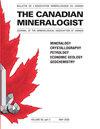Phosphate mineral associations from the Tres Arroyos aplite-pegmatites (Badajoz, Spain): Petrography, mineral chemistry, and petrogenetic implications
IF 1.5
4区 地球科学
Q3 MINERALOGY
引用次数: 2
Abstract
In the Tres Arroyos granite-pegmatite system (Badajoz, Spain) a zoned aplite-pegmatite field occurs, with poorly evolved, intermediate, and Li-rich dikes intruded into metasediments, close to the contact with the Nisa-Alburquerque granitic batholith. A large variety of Fe-Mn phosphate minerals occur in the poorly evolved aplite-pegmatites; Al-phosphates occur mainly in the intermediate and Li-rich dikes. The Fe/(Fe + Mn) ratio of the Fe-Mn phosphates is the highest reported for aplite-pegmatite fields in the Central Iberian Zone, suggesting a low degree of fractionation for the poorly evolved aplite-pegmatites that host these minerals. In contrast, the high F contents observed in crystals of the amblygonite–montebrasite series from the intermediate and Li-rich aplite-pegmatites indicates a higher fractionation degree for these dikes. The relatively common occurrence of phosphate minerals in the three types of aplite-pegmatites from Tres Arroyos attests to a significant availability of P in the pegmatitic melt. In this granite pegmatite system, P first started behaving as a compatible element, thus favoring the crystallization of discrete phosphates, during the crystallization of the poorly evolved aplite-pegmatites. In more fractionated melts, where Fe-Mn-(Mg) contents were extremely depleted, P was still available, allowing the crystallization of the Al-phosphates, mainly of the amblygonite–montebrasite series, in the more evolved intermediate and Li-rich aplite-pegmatites. Subsolidus replacement of the early phosphate phases, such as those of the amblygonite–montebrasite series, by lacroixite, together with the presence of late Ca- and Sr-bearing phosphates such as jahnsite-(CaMnFe), whiteite-(CaFeMg), mitridatite, and goyazite, attest to a high activity of metasomatic fluids in the Tres Arroyos granite-pegmatite system. Consequently, variations in the phosphate mineral associations and in their chemical compositions reflect well the fractional crystallization processes suffered by the pegmatitic melts from the poorly evolved up to the Li-rich dikes, as well as the subsolidus history of the Tres Arroyos system.Tres Arroyos钠晶伟晶岩(西班牙Badajoz)的磷矿组合:岩石学、矿物化学和岩石成因意义
在西班牙Badajoz的Tres Arroyos花岗伟晶岩体系中,发育一个分带状的长晶伟晶岩田,发育发育程度较差的中、富锂岩脉侵入变质沉积层,靠近Nisa-Alburquerque花岗岩体接触面。铁锰磷矿物种类繁多,赋存于发育较差的长晶伟晶岩中;磷酸铝主要赋存于中、富锂岩脉中。据报道,在伊比利亚中部的长晶伟晶岩中,Fe-Mn磷酸盐的Fe/(Fe + Mn)比率最高,这表明,这些矿物所在的长晶伟晶岩演化较差,分馏程度较低。而富锂镁辉长岩和富锂镁伟晶岩中辉长岩-蒙brasite系列晶体中F含量较高,表明这些岩脉具有较高的分馏程度。在阿罗约三种类型的长晶伟晶岩中相对常见的磷矿物证明了在伟晶岩熔体中P的显著可用性。在这个花岗伟晶岩体系中,P元素首先开始作为相容元素,从而有利于离散磷酸盐的结晶,这是在演化较差的长晶伟晶岩结晶过程中发生的。在分馏程度较高的熔体中,Fe-Mn-(Mg)含量极低,但P仍然存在,这使得磷酸铝(主要是辉长石-蒙太白石系列)在更进化的中间和富锂的长晶伟晶岩中结晶。早期的磷矿相,如弱光长辉石-孟长辉石系列的磷矿相,被硅长辉石取代,再加上晚期含钙和含锶的磷酸盐,如黄铁矿-(CaMnFe)、白铁矿-(CaFeMg)、粒晶岩和goyazite的存在,证明了特雷斯阿罗约斯花岗岩-伟晶岩体系中交代流体的高活性。因此,磷酸盐矿物组合及其化学成分的变化很好地反映了伟晶质熔体从贫演化到富锂岩脉所经历的分步结晶过程,以及特雷斯阿罗约斯体系的亚固体历史。
本文章由计算机程序翻译,如有差异,请以英文原文为准。
求助全文
约1分钟内获得全文
求助全文
来源期刊

Canadian Mineralogist
地学-矿物学
CiteScore
2.20
自引率
22.20%
发文量
45
审稿时长
4-8 weeks
期刊介绍:
Since 1962, The Canadian Mineralogist has published papers dealing with all aspects of mineralogy, crystallography, petrology, economic geology, geochemistry, and applied mineralogy.
 求助内容:
求助内容: 应助结果提醒方式:
应助结果提醒方式:


